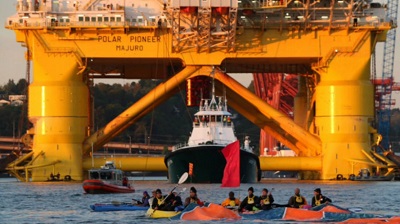Arctic Oil and Gas: Triumph and Disappointment in 2015
2015 was a year of both triumph and disappointment for the Arctic’s oil and gas industry. While some projects were abandoned, the region’s potential was highlighted, and the action continues into 2016.
Orders and Promises
Russia’s year in the Arctic saw a range of developments. Most recently, Sovcomflot gained finance for three Arctic shuttle tankers for the Novy Port project. Novy Port is one of the largest oil and gas condensate deposits on the Yamal peninsula in Russia. The vessels will serve as part of project infrastructure designed to enable year-round shipment of crude oil from an offshore loading terminal in the Gulf of Ob. The commercial production from the field will start in 2016.
 It was also a big year for Gazprom. Gazprom Chairman Alexey Miller underlined his company's commitment to the Russian Arctic region in his Christmas and New Year address. The address followed news that Gazprom's board of directors had approved a $11.8 billion investment program for 2016.
It was also a big year for Gazprom. Gazprom Chairman Alexey Miller underlined his company's commitment to the Russian Arctic region in his Christmas and New Year address. The address followed news that Gazprom's board of directors had approved a $11.8 billion investment program for 2016.
Noting Gazprom's leadership position in the Russian petroleum industry, Miller said:
"We have been efficiently developing the Prirazlomnoye field in the Arctic Shelf. In November, the amount of oil output reached one million [tons] there, and this vividly demonstrates that we operate this complex and extremely promising region in a productive and safe manner."
Gazprom Neft has brought its second well into production at the Prirazlomnoye field, with output totalling 1,800 tons per day. This increases production more than two-fold compared to 2014 production levels at Prirazlomnoye, which stood at 300,000 tons.
The Prirazlomnoye project is the first ever upstream project on the Russian Arctic Shelf, with a new type of oil, ARCO, launching on the international market in April 2014. The field is located in the Pechora Sea, 60 kilometers from shore.
The ice-resistant Prirazlomnaya rig was designed and constructed specifically for development of this field, capable of handling all technological operations — drilling, production, storage, and the preparation and offloading of the finished product.
Production using the Prirazlomnaya platform is predicated on the principle of zero emissions, with the platform equipped with a system to prevent the discharge of any production or drilling waste into the sea. Waste will, instead, be either directly re-injected into the strata, or will be transferred to the shore for recycling.
All wells to be drilled at Prirazlomnaya will be located within the platform, the base of which then acts as a buffer between the well and the open sea. In addition to which, all of the wells are specially equipped to prevent the possibility of any uncontrolled emission of oil or gas and can, if necessary, be hermetically sealed within 10 seconds.
However, the Prirazlomnoye field was the scene of an environmental protest in the autumn of 2013 that saw 30 Greenpeace member arrested by Russia on charges of piracy.
Cancelled Plans
Western oil majors also saw environmental activists drawing attention to their operations. In December Shell terminated its contract for the semi-submersible drilling rig the Polar Pioneer with Transocean.
The oil company had used the rig for its drilling campaign offshore Alaska, but in September it said it would stop its Alaskan operations for the forseeable future, citing bad drilling results and uncertain regulatory environment.
 In June, dozens of activists in kayaks tried to stop Polar Pioneer as it was towed out of its terminal at the Port of Seattle heading for the Arctic.
In June, dozens of activists in kayaks tried to stop Polar Pioneer as it was towed out of its terminal at the Port of Seattle heading for the Arctic.
Triumph and Disappointment
Shell’s decision to abandon its Alaskan drilling program sparked mixed reactions.
National Ocean Industries Association (NOIA) President Randall Luthi said: “It is disappointing on a number of fronts that due to a variety of factors, including regulatory constraints and cost issues, Shell has decided to halt their offshore drilling campaign in Alaska. First, the U.S. will lack energy source diversification for the foreseeable future since low oil prices and high drilling costs in the Arctic will likely impact future exploration activity in the Alaskan offshore continental shelf (OCS). Second, enormous economic opportunities for Native Alaskans have been delayed, if not lost, for the immediate future. Third, the U.S. will continue to lag other nations in the exploration and understanding of Arctic offshore areas.
“The groups cheering this news reveal the energy education disconnect in our country. The U.S. and world will need more energy sources, not fewer, in the coming decades, whether they be fossil fuels, which are estimated to still supply nearly 80 percent of the world’s energy needs in 2040, or renewable energy sources, such as wind, wave, current and solar.”
In contrast, Friends of the Earth Climate Campaigner Marissa Knodel: “As one of the largest corporations to pursue Arctic oil and gas, Shell’s retreat from a $7 billion gamble sends an important message: Arctic drilling is too dangerous and too expensive and should be stopped altogether. The stakes are too high for the environment, and not even Shell can cover a wager that could exacerbate climate change.”
Alaska’s Future Potential
Yet, the potential of Alaska’s offshore reserves remains and the story is far from over. The state’s Arctic offshore regions potentially hold tremendous stores of recoverable crude oil on par with or exceeding other major U.S. regions, according to a U.S. Energy Information Administration (EIA) report released earlier this year.
The Bureau of Ocean Energy Management estimates that the Chukchi Sea, off the northwest coast of Alaska, contains two to 40 billion barrels of unproved technically recoverable crude oil resources. Additionally, the area is estimated to hold between 10 to 210 trillion cubic feet of unproved technically recoverable natural gas resources.
Shell is fighting to preserve its U.S. drilling rights in Arctic waters, and in December, the company filed a notice of appeal challenging the Interior Department's October 29 rejection of the company's requests to stop the clock on Arctic oil and gas leases that otherwise expire between 2017 and 2020.
The dispute may not be resolved until after a new U.S. president takes office in 2016.
The opinions expressed herein are the author's and not necessarily those of The Maritime Executive.
